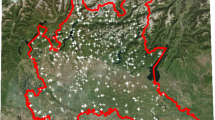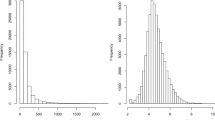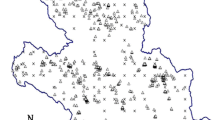Abstract
Radon-222 is a naturally occurring radioactive gas arising from the decay of Uranium-238 present in the earth’s crust. The knowledge of the radon effects on human health is generating a growing attention by national and international authorities aimed at assessing the exposure of people to this radioactive gas and identifying building types and geographic areas where high indoor radon concentrations (IRCs) are likely to be found. However, given its multi-factorial dependence and the substantial regional variation, the analysis of IRC is not a simple task. There have been several efforts to evaluate the impact of the major influencing factors on IRCs. In this paper we illustrate how the complex relationships between the IRCs and a set of associated variables can be analysed using profile regression, a Bayesian non-parametric model for clustering responses and regressors simultaneously. Analyzing a geo-referenced database of annual IRCs for the Abruzzo region (Central Italy), we show that the proposed methodology allows to identify clusters of buildings according to their proneness to IRCs and that, through cluster assignment, it is possible to disentangle the effect of regressors on IRC and predict its levels for specific combinations of the explanatory variables.





Similar content being viewed by others
References
Appleton J, Miles JCH, Green BMR, Larmour R (2008) Pilot study of the application of tellus airborne radiometric and soil geochemical data for radon mapping. J Environ Radioact 99(10):1687–1697
Appleton JD, Miles JCH, Young M (2011) Comparison of Northern Ireland radon maps based on indoor radon measurements and geology with maps derived by predictive modelling of airborne radiometric and ground permeability data. Sci Total Environ 409(8):1572–1583
Apte MG, Price PN, Nero AV, Revzan KL (1999) Predicting New Hampshire indoor radon concentrations from geologic information and other covariates. Environ Geol 37:181–194
Bigelow JL, Dunson DB (2009) Bayesian semiparametric joint models for functional predictors. J Am Stat Assoc 104:26–36
Blyth CR (1972) On Simpson’s paradox and the sure-thing principle. J Am Stat Assoc 67:364–366
Borgoni R (2011) A quantile regression approach to evaluate factors influencing residential indoor radon concentration. Environ Model Assess 16:239–250
Bossew P, Dubois G, Tollefsen T (2008) Investigations on indoor Radon in Austria, part 2: geological classes as categorical external drift for spatial modelling of the Radon potential. J Environ Radioact 99(1):81–97
Chilés JP, Delfiner P (1999) Geostatistics: modeling spatial uncertainty. Wiley, New York
Curtis SM, Ghosh SK (2011) A Bayesian approach to multicollinearity and the simultaneous selection and clustering of predictors in linear regression. J Stat Theory Pract 5(4):715–735
D’Alessandro L, Miccadei E, Piacentini T (2003) Morphostructural elements of central-eastern Abruzzi: contributions to the study of the role of tectonics on the morphogenesis of the Apennine chain. Quat Int 99(1):115–124
Darby S, Hill D, Auvinen A, Barros-Dios JM, Baysson H, Bochicchio F, Deo H, Falk R, Forastiere F, Hakama M, Heid I, Kreienbrock L, Kreuzer M, Lagarde F, Mäkeläinen I, Muirhead C, Oberaigner W, Pershagen G, Ruano-Ravina A, Ruosteenoja E, Rosario AS, Tirmarche M, Tomàsek L, Whitley E, Wichmann HE, Doll R (2005) Radon in homes and risk of lung cancer: collaborative analysis of individual data from 13 European case-control studies. Br Med J 330(7485):223
Datta A, Banerjee S, Finley AO, Gelfand AE (2016) Hierarchical nearest neighbor gaussian process models for large geostatistical datasets. J Am Stat Assoc 111:800–812
Demoury C, Ielsch G, Hemon D, Laurent O, Laurier D, Clavel J, Guillevic J (2013) A statistical evaluation of the influence of housing characteristics and geogenic radon potential on indoor radon concentrations in France. J Environ Radioact 126:216–225
Fontanella L, Ippoliti L, Valentini P (2013) A functional spatio-temporal model for geometric shape analysis. In: Pesarin F, Torelli N, Bar-Hen A (eds) Adv Theor Appl Stat. Springer, Berlin Heidelberg, pp 75–86
Fontanella L, Ippoliti L, Sarra A, Valentini P, Palermi S (2015) Hierarchical generalised latent spatial quantile regression models with applications to indoor radon concentration. Stoch Environ Res Risk Assess 29:357–367
Fontanella L, Sarra A, Valentini P, Palermi S (2016) Quantile regression and Bayesian cluster detection to identify radon prone areas. J Environ Radioact 164:354–364
Fontanella L, Ippoliti L, Valentini P (2019) Predictive functional anova models for longitudinal analysis of mandibular shape changes. Biometrical J. https://doi.org/10.1002/bimj.201800228
Friedmann H (2005) Final results of the Austrian radon project. Health Phys 89(4):339–348
Gunby JA, Darby SC, Miles JCH, Green BM, Cox DR (1993) Factors affecting indoor radon concentrations in the United Kingdom. Health Phys 64:2–11
Hastie DI, Liverani S, Azizi L, Richardson S, Stücker I (2013) A semi-parametric approach to estimate risk functions associated with multi-dimensional exposure profiles: application to smoking and lung cancer. BMC Med Res Methodol 13:129
Hoerl AE, Kennard RW (1970) Ridge regression: biased estimation for nonorthogonal problems. Technometrics 12:55–67
ISPRA (2012) Cartografia geologica d’italia alla scala \(1:50.000\). in: Servizio geologico d’italia e progetto carg. Technical report
Jain S, Neal RM (2007) Splitting and merging components of a nonconjugate Dirichlet process mixture model. Bayesian Anal 2(3):445–472
Kemsky J, Klingel R, Siehl AR, Valdivia-Manchego M (2009) From radon hazard to risk prediction-based on geological maps, soil gas and indoor measurements in Germany. Environ Geol 56(7):1269–1279
Kreienbrock L, Kreuzer M, Gerken M, Dingerkus G, Wellmann J, Keller G, Wichmann HE (2001) Case-control study on lung-cancer and residential radon in Western Germany. Am J Epidemiol 89(4):339–348
Krewski D, Lubin JH, Zielinski JM, Alavanja M, Catalan VS, Field RW, Klotz JB, Letourneau EG, Lynch CF, Lyon JI, Sandler DP, Schoenberg JB, Steck DJ, Stolwijk JA, Weinberg C, Wilcox HB (2005) Residential radon and risk of lung cancer: a combined analysis of 7 North American case-control studies. Epidemiology 16(4):137–145
Kropat G, Bochud F, Jaboyedoff M, Laedermann J, Murith C, Palacios M, Baechler S (2015) Predictive analysis and mapping of indoor radon concentrations in a complex environment using kernel estimation: an application to Switzerland. Sci Total Environ 16(4):137–148
Lecomte JF, Solomon S, Takala J, Jung T, Strand P, Murith C, Kiselev S, Zhuo W, Shannoun F, Janssens A (2014) ICRP publication 126: radiological protection against radon exposure. Ann of ICRP 43:5–73
Liverani S, Hastie DI, Papathomas M, Richardson S (2015) PReMiuM: an R package for profile regression mixture models using Dirichlet processes. J Stat Softw 64(7):1–30
Liverani S, Lavigne A, Blangiardo M (2016) Modelling collinear and spatially correlated data. Spatial Spatio-temporal Epidemiol 18:63–73
Mardia KV, Kent JT, Goodall CR, Little JA (1996) Kriging and splines with derivative information. Biometrika 83:207–221
Mardia KV, Redfern E, Goodall CR, Alonso F (1998) The Kriged Kalman filter. Test 59:217–285
Molitor J, Papathomas M, Jerrett M, Richardson S (2010) Bayesian profile regression with an application to the National Survey of Children’s Health. Biostatistics 11(3):484–498
Molitor J, Su JG, Molitor NT, Rubio VG, Richardson S, Hastie D, Morello-Frosch R, Jerrett M (2011) Identifying vulnerable populations through an examination of the association between multipollutant profiles and poverty. Environ Sci Technol 45(3):7754–7760
Molitor J, Brown IJ, Chan Q, Papathomas M, Liverani S, Molitor N, Richardson S, Van Horn L, Daviglus ML, Dyer A, Stamler J, Elliott P, INTERMAP Research Group (2014) Blood pressuredifferences associated with optimal macronutrient intake trial forheart health (OMNIHEART)-like diet compared with a typical Americandiet. Hypertension 64:1198–1204
Ohlssen D, Sharples L, Spiegelhalter D (2007) Flexible random-effects models using Bayesian semi-parametric models: applications to institutional comparisons. Stat Med 26:2088–2112
Palermi S, Pasculli A (2008) Radon mapping in abruzzo, italy. In: Proceedings of 4th Canadian conference on Geohazards Quèbec City Canada
Palermi S, Carnesale L, Buccella G, Rancitelli D, Sulli G, Benedetti F, Capannolo R, Gianfelice G, Di Giansante A (2012) Indagine per la mappatura del radon in abruzzo. In:Proceedings del V Convegno Nazionale sugli Agenti Fisici
Papathomas M, Molitor J, Richardson S, Riboli E, Vineis P (2011) Examining the joint effect of multiple risk factors using exposure risk profiles: lung cancer in non smokers. Environ Health Perspect 119:84–91
Papathomas M, Molitor J, Hoggart C, Hastie D, Richardson S (2012) Exploring data from genetic association studies using Bayesian variable selection and the Dirichlet process: application to searching for gene x gene patterns. Genet Epidemiol 36:663–674
Pasculli A, Palermi S, Sarra A, Piacentini T, Miccadei E (2014) A novel modelling methodology for the analysis of radon potential based on environmental geology and Geographically Weighted Regression approach. Environ Model Softw 54:165–181
Pirani M, Best N, Blangiardo M, Liverani S, Atkinson RW, Fuller GW (2015) Analysing the health effects of simultaneous exposure to physical and chemical properties of airborne particles. Environ Int 79:56–64
Price PN, Nero AV, Gelman A (1996) Bayesian prediction of mean indoor radon concentrations for Minnesota Counties. Health Phys 71:922–936
R Development Core Team (2017) R: a language and environment for statistical computing. Technical report. R Foundation for Statistical Computing, Vienna. http://www.R-project.org
Robertson A, Allen J, Laney R, Curnow A (2013) The cellular and molecular carcinogenic effects of radon exposure: a review. Int J Mol Sci 14(7):14024–14063
Rue H, Held L (2005) Gaussian Markov random fields: theory and applications. Chapman and Hall, New York
Smethurst MA, Strand T, Sundal AV, Rudjord AL (2008) Large-scale radon hazard evaluation in the Oslofjord region of Norway utilizing indoor radon concentrations, airbone gamma spectrometry and geological mapping. Sci Total Environ 407:379–393
Smith BJ, Field RW (2007) Effect of housing factors and surficial uranium on the spatial prediction of residential radon in Iowa. Environmetrics 18:481–497
Tibshirani R (1996) Regression shrinkage and selection via the lasso. J R Stat Soc Ser B 58:267–288
Vrijheid M, Slama R, Robinson O, Chatzi L, Coen M, van den Hazel P, Thomsen C, Wright J, Athersuch TJ, Avellana N, Basagaña X, Brochot C, Bucchini L, Bustamante M, Carracedo A, Casas M, Estivill X, Fairley L, van Gent D, Gonzalez JR, Granum B, Gražulevičiene R, Gutzkow K, Julvez J, Keun HC, Kogevinas M, McEachan RRC, Meltzer HM, Sabidò E, Schwarze PE, Siroux V, Sunyer J, Want E, Zeman F, Nieuwenhuijsen MJ (2014) The human early-life exposome (HELIX): project rationale and design. Environ Health Perspect 122:535–544
World Health Organization (2009) WHO handbook on indoor radon: a public health perspective. World Health Organization, Geneva
Zou T, Hastie T (2005) Regularization and variable selection via the elastic net. J R Stat Soc Ser B 67:301–320
Acknowledgements
The authors would like to thank the Editor-in-Chief, the Associate Editor and the referees for their helpful comments and suggestions. LI, LF and EN were partially funded by the grant MIUR, Ministero dell’Istruzione, dell’Università e della Ricerca, PRIN research project 2015 “Environmental processes and human activities: capturing their interactions via statistical methods”-EphaStat. The authors also thank Dr. Roberto Luis Di Cesare of ARTA Abruzzo for making the maps in ArcGis.
Author information
Authors and Affiliations
Corresponding author
Additional information
Handling Editor: Bryan F. J. Manly.
Appendices
Appendices
Appendix A: Model parametrization
This Section provides details about the values chosen for the hyperparameters of the BPR model to obtain results discussed in Sect. 4. The setting follows suggestions given in Liverani et al. (2016).
Distinctively, for the stick-breaking process we have set \(s_{\alpha }=2\) and \(r_{\alpha }=1\) which refer to the shape and rate parameter for the Gamma prior on \(\alpha \), respectively. Further, each element of the vector of the parameters for the Dirichlet prior on \(\phi _{p}\), \((a_{1}, \ldots a_{P},)\) is set to 1. For each cluster c, following Liverani et al. (2016), we adopt a t location-scale distribution on \(\theta _{c}\), with hyperparameters \(\mu _\theta \) and \(\sigma _\theta \) with 7 degrees of freedom. The location parameter (\(\mu _{\theta }\)) and the scale parameter (\(\sigma _{\theta }\)) are equal to 0 and 2.5, respectively. We adopt the same prior for the \(\varvec{\beta }_2\), with hyperparameters \(\mu _\beta =0\) and \(\sigma _\beta =2.5\). Finally, for the precision parameter \(\sigma ^{-2}_\epsilon \) we consider a Gamma distribution with shape and rate (inverse scale) parameters both fixed at 2.5.
Appendix B: Model predictive accuracy and residual analysis
Appendix C: Posterior distribution of all cluster specific parameters
Rights and permissions
About this article
Cite this article
Fontanella, L., Ippoliti, L., Sarra, A. et al. Investigating the association between indoor radon concentrations and some potential influencing factors through a profile regression approach. Environ Ecol Stat 26, 185–216 (2019). https://doi.org/10.1007/s10651-019-00424-5
Received:
Revised:
Published:
Issue Date:
DOI: https://doi.org/10.1007/s10651-019-00424-5










